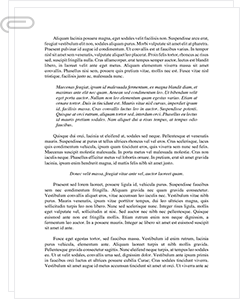 Study Document
Study Document
21st Amendment and Its Impact Term Paper
Pages:6 (1727 words)
Sources:1+
Subject:Government
Topic:Constitutional Amendments
Document Type:Term Paper
Document:#15865460
S. Constitution began yet another short-lived experiment with prohibition, only this time it was on a national level. When it went into effect in January 1920, efforts to repeal the 18th Amendment began almost immediately. In a whirlwind of legislative activity, the 21st Amendment was ratified by the requisite number of states in record time. In their haste to repeal the 18th Amendment, though, lawmakers failed to consider the impact of section two as it might apply to interstate commerce in the Age of Information, but given the heated nature of the debate at the time, they can perhaps be forgiven this legislative oversight in the 21st century. All in all, though, the research clearly showed that the U.S. Constitution remains a living document that is capable of responding to changes in American society.
Works Cited
Bryce, Jenny. (2000). "Prohibition in the United States." History Review, 37.
Eng, Gordon. (2003). "Old Whine in a New Battle: Pragmatic Approaches to Balancing the Twenty-First Amendment, the Dormant Commerce Clause, and the Direct Shipping of Wine." Fordham Urban Law Journal 30(6):1849.
Kyvig, David E. Law, Alcohol, and Order: Perspectives on National Prohibition. Westport, CT: Greenwood Press, 1985.
Livingston, William S. Federalism and Constitutional Change. Oxford: Clarendon Press, 1956.
Nielson, Aaron. (2004). "No More 'Cherry-Picking': The Real History of the 21st Amendment's (Section) 2."…
Sample Source(s) Used
Works Cited
Bryce, Jenny. (2000). "Prohibition in the United States." History Review, 37.
Eng, Gordon. (2003). "Old Whine in a New Battle: Pragmatic Approaches to Balancing the Twenty-First Amendment, the Dormant Commerce Clause, and the Direct Shipping of Wine." Fordham Urban Law Journal 30(6):1849.
Kyvig, David E. Law, Alcohol, and Order: Perspectives on National Prohibition. Westport, CT: Greenwood Press, 1985.
Livingston, William S. Federalism and Constitutional Change. Oxford: Clarendon Press, 1956.
Related Documents
 Study Document
Study Document
Constitutional Amendment
The First Amendment
The First Amendment states that “Congress shall make no law respecting an establishment of religion, or prohibiting the free exercise thereof; or abridging the freedom of speech, or of the press; or the right of the people peaceably to assemble, and to petition the Government for a redress of grievances.” This Amendment basically protects free speech, among other rights—but in recent years it has been necessary to
 Study Document
Study Document
Impact of Brown Vs Board of Education
Racial Equality Like other forms of discrimination and bigotry in the United States, racism has thankfully started to tail off and reduce over the years and generations. However, this is happening at a pace that is frustratingly slow and plodding. Court decisions and new laws passed throughout the 20th and 21st centuries have led to more inclusion and less institutional racism and other bigotry. However, de facto racism and other forms
 Study Document
Study Document
21st Century the Contract of
The most notable would include: the 1976 Racial Discrimination Act, 1981 Handicapped Persons Equal Opportunity Act, the 1984 Equal Opportunity Act, 1989 Equal Opportunity Amendment Act -- Intellectual Disability, 1990 Equal Opportunity Amendment Act -- Age, 1993 Compulsory Retirement Abolished, 1997 Equal Opportunity Amendment Act -- Sexual Harassment and the 2009 Equal Opportunity Amendment Act -- New Grounds. ("History of Equal Opportunity in South Australia," 2010) These different laws
 Study Document
Study Document
Impact of School Culture on School Safety
School Culture on School Safety Many studies have been done on safety in schools. Likewise, many studies have been done on the culture of various schools. Unfortunately, there has not been significant research on a link between the two. This is not to say that these kinds of studies have not been done, but rather that there has not been enough of them. Many of the studies that have been
 Study Document
Study Document
Gun Control in the 21st
Hence, while ratifying the U.S. Constitution, the Virginia convention passed a resolution specifying: "That the people have a right to keep and bear arms; that a well-regulated militia, composed of the body of the people trained to arms, is the proper, natural, and safe defense of a free state;" It is, therefore, clear that the central issue that led to the adoption of the Second Amendment, as part of the
 Study Document
Study Document
1st Amendment Issues a Highly Controversial Decision
1st Amendment Issues A highly controversial decision rendered on January 21st of this year by the Supreme Court, affirming the right of corporations and other organizations to enjoy consideration as "persons" and the 1st amendment protections afforded by that status, threatens to undermine the foundation of this country's democratic process. With their closely contested 5-4 decision in the case of Citizens United v. FEC, the high court's conservative members have



